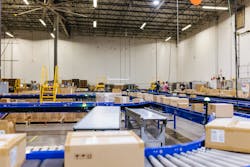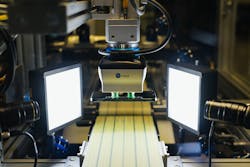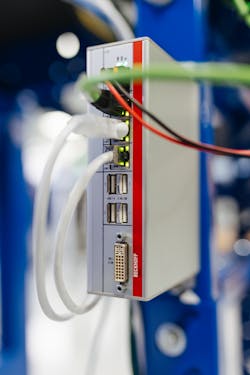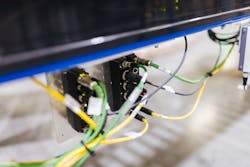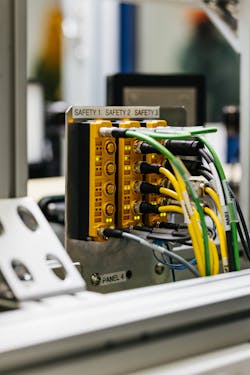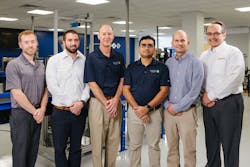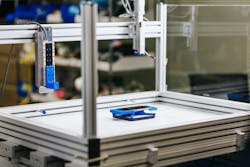CTDI revolutionizes intralogistics with Beckhoff's scalable automation solutions
More than likely, the biggest player in intralogistics you’ve never heard of is Communications Test Design (CTDI). Based in West Chester, Pennsylvania, CTDI offers reverse and forward logistics for the world’s telecommunications carriers, cable service providers and smartphone devices. The family-owned company operates 100 facilities globally with more than 20,000 employees. To remain as technologically advanced as its customers, CTDI has invested heavily in automation in recent years, says CTDI Director Mark Parsons.
CTDI was founded in 1975 by Don and Jerry Parsons and has grown into a global engineering, repair and logistics company. CTDI has a long history of test engineering expertise that has delivered technical services throughout its 47-year history. In 2021, CTDI established a dedicated warehouse automation team that is solely focused on modular automation innovation, which supports CTDI’s growing services globally.
To get the group up to speed quickly, Kirk Whittemore joined CTDI as general manager of the Automation Group. For the engineers on Whittemore’s team, the company provides research-and-development (R&D) resources as it completes everything from design and programming to wiring and system commissioning in-house. However, the task also requires an understanding of the huge range of company activities, the massive sizes of the facilities, how to avoid scope creep and what to look for in technology partners (Figure 1).
“We need to build modularity into our systems and standardize on the right vendors,” Whittemore says. “Beckhoff was a clear choice to be our automation technology partner. Their controls and networking technologies enable plug-and-play solutions across all our different automated systems, with extensibility for the future. This helps optimize projects like our fully automated, robotic picking line.”
CTDI is just one of the companies that operates as both end user and OEM that is focusing on flexible automation systems in warehouse and fulfillment operations, says Doug Schuchart, global material handling & intralogistics manager at Beckhoff. “More than ever, companies like CTDI must remain nimble to rapidly changing markets and consumer demands,” he emphasizes. “This is yet another benefit that Beckhoff users gain with our flexible automation solutions, as well as improved system lifecycle with full protection from system obsolescence, which is another important factor in helping our customers remain competitive.”
A custom solution for universal use
As the CTDI warehouse automation team quickly got up to speed, the engineers began to answer their core question: How can CTDI implement standardized systems to speed up delivery times, nimbly adjust to changing customer requirements and scale for peak seasons when each distribution center is so different?
“Our team needed to establish basic principles of how we wanted to approach these projects,” Whittemore explains. “First, we decided not to tackle entire buildings, like a warehouse integrator would, but instead solve strategic problems in a modular way. If we can eliminate a pain point for, say, $1 million, then we can implement that at select branches across our network. Globally, flexible systems like our automated picking line provide more value than dedicating massive resources to one multi-million-dollar upgrade that doesn’t scale.”
The concept for the automated picking line leverages CTDI’s standard robotic cell for several tasks (Figure 2). One robot serves as a flexible carton erector to build different sizes of boxes, depending on the type or quantity of product, then places the carton on a conveyor. Next, the cartons are labeled with a unique barcode and weighed. Another robotic cell loads product. Then a final robot adds paperwork or other collateral before the box is weighed, sealed and labeled. At each step, scanners confirm the box and product are correctly matched.
If greater throughput is necessary, the team can deploy additional robot cells for whichever task is the bottleneck (Figure 3). “With this modular approach, we can develop and approve standardized systems that scale across multiple sites,” adds Parsons. This approach requires not just standardized robots and conveyor, but also modular controls, as well as networking and programming technologies to make them all work together seamlessly.
Automation software, hardware and networking deliver scalability
Automation technology from Beckhoff extends two advantages to CTDI’s modular fulfillment systems, says Soham Patwardhan, control systems architect at CTDI. The first is the ability to develop internal libraries in TwinCAT 3 automation software. TwinCAT enables the CTDI warehouse automation team to program in a variety of languages depending on the project, and it also provides a deterministic runtime. The Library Manager in TwinCAT streamlines version control and implementation of standardized code in the field.
“With TwinCAT, we can create code for our standard equipment—for example, a robot, scanner or conveyor—so that it is able to operate in different modes and apply to almost any situation,” Patwardhan says. “The code lives on our internal engineering drive, and we simply install it as a library on all the different systems. When we tested this, the standardized approach sped up deployment. This gets us one step closer to plug-and-play capabilities.”
The PC-based control philosophy also facilitates communication from warehouse and test automation systems to CTDI’s warehouse management software (WMS). “Some of our systems that interact with our WMS also have a global component, such as a test application or middleware, for system communication and other processes. Our standard is Visual Studio with .NET and C# for our code development,” Patwardhan explains. Having automation device specification (ADS) protocol in TwinCAT to communicate between the programmable logic controller (PLC) and the .NET has been immensely helpful, adds Patwardhan.
CTDI uses the TwinCAT IoT library to send data between the WMS and the Beckhoff machine controllers. This has reduced additional programming requirements significantly in applications with no test app. “The PLC can directly communicate with a warehouse management system or warehouse execution system (WES), which is much more efficient than our old way of using a C# middle layer,” Patwardhan says. “Using tools in the TwinCAT IoT library is also more scalable and stable from a performance standpoint.”
“This scalability of Beckhoff’s machine control portfolio has proven important to CTDI,” Schuchart adds. “When switching controllers to match performance requirements, the engineers do not need to worry about a hardware rip-and-replace scenario or even software changes in TwinCAT. The Beckhoff architecture is fully integrated, which safeguards our customers’ control hardware, code base and I/O against obsolescence.”
The second critical advantage of working with Beckhoff, says Patwardhan, is the strength of the EtherCAT industrial Ethernet system. “EtherCAT has helped immensely in standardizing designs for our flexible systems,” he says. “We do not have network-related maintenance, configurations or any of the issues typical of other networks since EtherCAT automatically scans in connected devices. It’s also extremely easy when it comes to network topologies and to the architecture, because you are not confined like switch-based networks.” Even on CTDI’s largest systems with up to 2,000 linear feet of conveyors, a single EtherCAT network can handle communication without any effects on performance.
Results arrive right on schedule
By building modularity into every system, the CTDI warehouse automation team is able to tackle a project, such as an automated picking line, in six months that would normally take a warehouse integrator a year, says Whittemore. In addition, the engineers in the field make the maintenance technician part of the team during the install so that individual fully understands the equipment.
The automated picking line boosts throughput significantly for picking and shipping orders from 180 per hour in a completely manual process to upwards of 450. This helps CTDI warehouse managers handle fluctuating demands.
EtherCAT and flexible machine control from Beckhoff provide benefits during commissioning and operation (Figure 7).
“As an example, we recently installed a line with 20 EtherCAT I/O Box modules and about the same amount of additional field devices,” Patwardhan says. “Using EtherNet/IP or another IP-based protocol, scanning and configuring this system would normally take two hours. With EtherCAT, it takes just five minutes to scan in all devices, so it's a tremendous time savings for us.”
What initially attracted CTDI to Beckhoff was the ability to use a Windows environment to run both machine control logic and the company’s house-developed testing programs, which grade returned electronics, on the same control hardware. The inherent connectivity of PC-based control technology also boosts commissioning and maintenance. “When I am in the field, it is tremendously valuable to be able to have my team in West Chester log on to the system via our internal network to answer my questions, solve issues or make quick changes,” Whittemore explains.
This is possible because Beckhoff controllers are architected much like other PLCs, Schuchart adds. “However, our customers can run tasks on separate cores of a multi-core processor and run third-party software,” says Schuchart. “We see this often in the intralogistics market with companies running a warehouse management system or warehouse control system (WCS) or other software as does CTDI. Engineers can use Windows or a non-Windows operating system (OS). They can even run the TwinCAT project in a non-Windows environment and run Windows applications in a separate virtual environment on the same hardware. This gives their systems incredible flexibility to meet their customer’s requirements.”
The Beckhoff architecture also streamlines the collection and transmission of data to the WMS to continue to enhance CTDI’s equipment to meet the challenges of forward and reverse logistics. “Reverse logistics is challenging because there’s less control over which products are coming in, how they’re packaged and what the condition is,” Parsons says. “Although forward logistics is more controlled and has fewer unknowns, every single order is a custom order. Our dynamic equipment must communicate between our WMS and our control system in real time, and flexible automation technology is critical to fulfill each order on time every time.”
Investment in innovation
Over nearly five decades, CTDI’s philosophy has been to invest in, standardize on and scale with technology. The distribution-and-test-automation company strives to keep pace in its test automation, warehouse automation and warehouse management systems. One way that CTDI accomplishes this is by investing in technologies without requiring them to be tied to specific applications.
At the company’s innovation lab in West Chester, the automation teams are evaluating adaptive automation with an XPlanar starter kit. Beckhoff’s “flying motion” system with six degrees of freedom in movement offers potential for streamlining forward and reverse logistics processes. CTDI also looks forward to working with the emerging robot solution from Beckhoff—Automation Technology for Robotics (ATRO)—to support CTDI’s modular machine concepts.
About the Author
Mike Bacidore
Editor in Chief
Mike Bacidore is chief editor of Control Design and has been an integral part of the Endeavor Business Media editorial team since 2007. Previously, he was editorial director at Hughes Communications and a portfolio manager of the human resources and labor law areas at Wolters Kluwer. Bacidore holds a BA from the University of Illinois and an MBA from Lake Forest Graduate School of Management. He is an award-winning columnist, earning multiple regional and national awards from the American Society of Business Publication Editors. He may be reached at [email protected]

Leaders relevant to this article:

